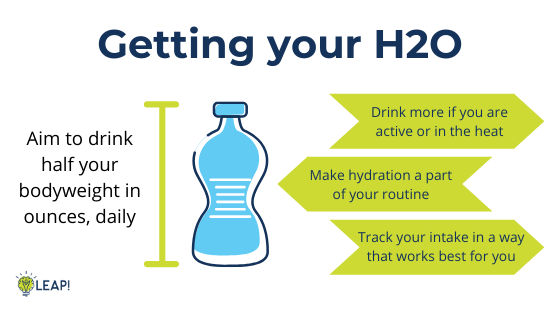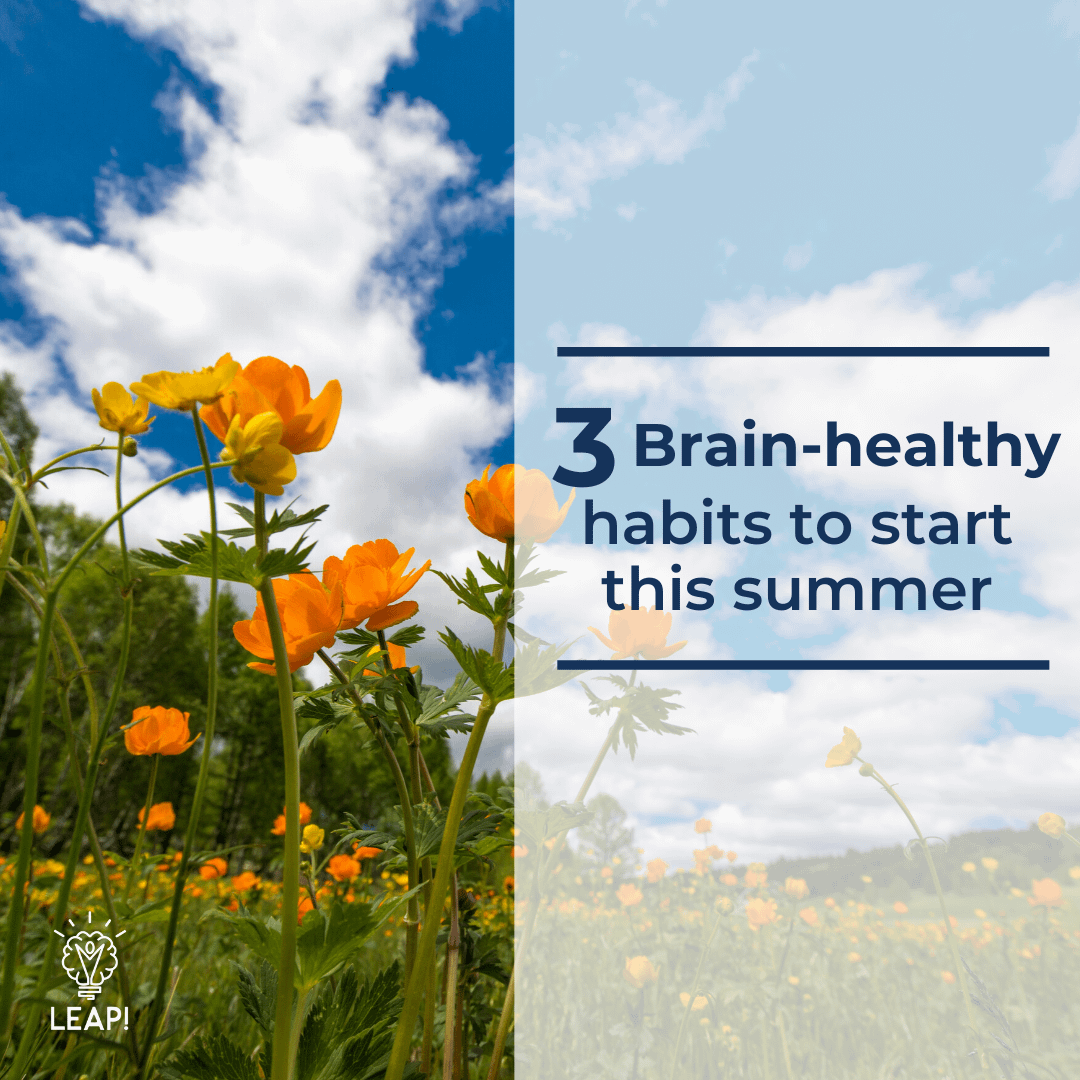Sunny days and warm nights are finally back as the first month of the summer kicks off! In this post, we’re discussing 3 habits for a brain-healthy summer. Read below as we detail the science behind these strategies, as well as some tips to help you reach your goals.
Hydrate
Staying hydrated is important—especially in the summer months when the temperature rises and we spend more time outdoors.
Evidence suggests that children and older adults are most at risk for voluntary dehydration, which occurs due to the lack of awareness of how much water we need¹. Typically, recommendations for water intake are to drink eight 8-ounce glasses or half your body weight in ounces, daily. (Most people have an easier time remembering this “8 by 8” rule of thumb.) If you exercise and/or spend time in the heat, increase your intake. Pregnant or breastfeeding women are also recommended to drink more water².
How can you tell if you’re hydrated enough?
You are likely adequately hydrated if you rarely feel thirsty and if your urine is clear or light yellow². If the color is darker yellow, your body needs more water, although the B vitamin riboflavin can temporarily cause urine to look bright yellow or neon. If you take a multivitamin or B complex, this will likely cause your urine to look more yellow than it is.
Some effects of mild dehydration may also include a disruption in mood, impaired short-term memory, headaches, and decreased concentration and alertness³. One study suggested that our visual perception abilities can be impaired, too, if dehydration becomes severe¹.
Though more studies are needed to determine a clear link between water and brain health, we know that water is an essential nutrient for waste removal and transportation of important compounds in the bodies. Ultimately, this can help reduce our risk for chronic health conditions that can be precursors for AD.
Since we also know that staying hydrated can be difficult, we’ve got some tips for you!
- Choose a water bottle that’s right for you.
Water bottles come in different shapes, sizes and materials, so it’s important to consider what your daily tasks require and what’s most convenient for you—if you’re at work, at home, or outdoors. This guide from Vitamix helps you make that decision on what to purchase.
Recently, one popular trend has been to purchase water bottles that indicate how much you’ve drank, or to make one on your own!
Make your own time-increment water bottle with this tutorial, or check out your options to purchase one here.
- Try a hydration app.
There’s an app for everything these days, including for staying hydrated. Check out these 5 highly-rated apps from this past year.
The perks of using an app are the convenient tracking abilities and daily reminders to drink up—you can also set your own hydration goals. This is especially helpful if you tend to forget to drink water or if you tend to drink it in one or two bouts, instead of throughout the day.
- Drink water as part of a routine.
You’ll be less likely to forget to drink water if you sip before, during, or after your everyday tasks.
Start your day with a full glass of water—this is especially helpful after a night’s rest with no hydration. Drink a glass of water with every meal, after every bathroom break, or during any exercise. Drink a glass while your coffee brews, after switching laundry, or during a commercial break. The goal is to associate H2O with what’s easiest for your everyday lifestyle!
- Infuse your water.
Some of us don’t love the taste of water, and that’s the hardest part of hydration. If this is the case for you, try some ways to make water taste great—all you need is a pitcher, cold water, and your choice of fresh produce.
We love these ideas for infused flavors from the Eating Bird Food nutrition blog.
There are combinations for every palate, and the web is full of more ideas!

Color your Plate
We know fruits and vegetables are good for us, but you’ve probably wondered why.
Fruits and vegetables are packed with phytonutrients—powerful plant compounds that have been proven to help reduce our risk for chronic disease⁴.
Phytonutrients help get rid of toxins in our bodies, boost our immunity, help improve heart health, and protect against different cancers⁴. It’s no wonder fruits and vegetables make up such a large portion of the Mediterranean diet for better brain health!
Eating a variety of fruits and vegetables is just as important as eating enough of them, that’s why we encourage you to color your plate with red, orange, yellow, green, blue, purple, and even white or tan produce.
With the summer months producing the largest amount of fresh produce, getting enough fruits and veggies should be no problem, right?
But we still know that increasing your intake can be hard, especially if you live in a household of picky eaters, or consider yourself to be one. Here are some tips for making fruits and vegetables taste great and adding them to your diet!
- Take a dip.
Fresh fruits and vegetables make for a nutritious snack. Though munching on some fresh fruit likely sounds appealing, eating some raw vegetables may not—unless you have something to dip them into.
We recommend making your own healthy, homemade dip with a base such as greek yogurt, avocado, or legumes (if you love hummus). Most recipes can be made with ingredients you have at home.
Try this Skinny Greek Yogurt Ranch Dip from nutrition blog Well Plated—the Greek yogurt makes it a good source of protein, too!
Love guacamole? Make this Avocado-Yogurt Dip from Eating Well. It’s creamy, smooth, and full of healthy fat—which pairs well with vegetables high in fat soluble vitamins, such as broccoli, carrots, and bell peppers⁴.
If you have some more time and ingredients on your hands, try making your own hummus! Here are 20+ creative recipes from Cooking Light for any flavor you want. Hummus is the perfect option for those who stick to dairy-free.
- Learn how to cook your veggies.
Cooked veggies are nutritious, too, though some cooking methods are healthier than others. Likewise, some methods are tastier than others.
But flavor is all in the prep and the technique—cooking veggies doesn’t have to be hard, nor does it have to compromise nutritional content. Some vegetables, in fact, have more available nutrients when they are cooked with a healthy fat (such as extra virgin olive oil)⁴.
Some general rules for cooking vegetables include using methods with as little water as possible and cooking only to the point at which veggies are tender, not soft⁴.
Steam your vegetables. This method is one of the healthiest and also one of the quickest—you can steam veggies on your stovetop or in your microwave. Read this post from The Spruce Eats nutrition blog for details on cooking times for different vegetables.
Use your oven! Roasted veggies are mouth-watering and make your kitchen smell great. This method is also perfect for getting your daily dose of extra virgin olive oil (EVOO)—another important component of the Mediterranean diet.
Timing is an important factor to keep in mind when roasting. To keep more nutrients in the vegetables you are roasting, you’ll want to cook only until they are tender.
This article from Eating Well is a good start for learning how to roast veggies and finding the perfect balance between flavor and nutrients.
Sauteing your vegetables is another way to get a boost of EVOO. Preheat your pan with 1 to 2 tablespoons of EVOO and again, cook just until tender.
- Drink your greens.
Smoothies are a great way to boost your fruit intake, but did you know you can drink your greens, too? You likely won’t even taste the greens, just the sweet, summer fruit!
Here’s a start to mastering the green smoothie this season. For optimal nutrition, aim for natural sweeteners and low-sugar bases, such as unsweetened almond milk or water. If you have trouble finding fresh fruit, choose frozen—it’s still packed with nutrients and adds some chill on a hot day. (Check the label for added ingredients.)
If you’re looking for a low-sugar option, check out these green, vegetable-only varieties.
- Amp up your salads.
Don’t settle for plain, green salads, try to add a little of every color!
Experiment with different flavors and textures—and don’t forget to add a protein and healthy fat to help keep you full. Some healthful options include beans, nuts, eggs, poultry, or fatty fish. The fats help boost your absorption of nutrients from the salad.
Check out these tips from nutrition blog Running on Real Food to give you some ideas for creating your own combinations!
- Go local.
Buying local is the best way to buy fresh produce. Visit your local farmer’s market or go berry picking this season—do your research ahead of time to know what to expect.
By shopping local, you’re more likely to know the integrity behind the product. For our readers located in the Kansas City area, check out kcfoodcircle.org for help finding local farmers and farmers markets. Nationwide, check out localharvest.org.

Get outside
The great outdoors may be better for you than you think. Scientific evidence suggests that spending time in green areas may be associated with less stress and reduced risk of depression and anxiety⁵. Increased energy, improved attention, and a boost in immunity are among some of the other suggested benefits⁶.
One theory known as attentional restoration theory (ART), argues that spending time in nature induces involuntary attention and helps spark feelings of well-being⁵. In contrast, urban environments invoke the opposite—their constant stimulation leads to cognitive overload.
We also know that spending time outside can help increase your uptake of vitamin D from the sunlight. Research suggests that vitamin D made in the skin may last up to twice as long as ingested vitamin D⁷.
Additionally, vitamin D has been found to help stimulate macrophages (white blood cells) in the brain, which may play a part in clearing out amyloid plaques, a likely indicator of AD⁸. In one study, older adults with less vitamin D had a higher incidence of dementia than older adults with sufficient vitamin D⁸.
This makes it clear that getting your “sunshine vitamin” is important. But what about wearing SPF, which blocks the UV rays that supply vitamin D?
According to a substantial amount of research, the protection sunscreen supplies from the Sun’s UV rays does not compromise our vitamin D uptake⁹. Though as little as 15 SPF blocks over 90 percent of the Sun’s UV rays, this is only if it’s used exactly as directed—the rest is easily absorbed as vitamin D. Talk to your healthcare provider about what SPF products work best for you.
Aside from loading up on SPF, be sure to wear a hat, sunglasses, and cool clothing. Drink plenty of water, too, and try some of the activities below.
- Go for a walk
Walking is a great way to get physically active and help reduce our risk—its benefits range from improved balance, strength, and coordination, to maintaining weight, to boosting mood.
In one study with older adults, walking was found to be associated with greater gray matter volume in the brain, a trait associated with reduced risk of cognitive impairment¹⁰.
Aim to make walking a part of your daily routine, whether it be alone, with a pet, or with a companion. Start small, and gradually increase your distance or pace to reap the benefits of walking as an aerobic activity.
Want a challenge? Try carrying some small weights, find a hill to incorporate into your route, or even take a hike! With any physical activity, be sure to talk with your healthcare provider if you have concerns.
- Do yard work
Don’t underestimate work in your yard as physical activity, it can become a full body workout!
Mow and water your lawn, plant some flowers, find something to fix, clean, or revamp, or simply play some yard games to get the whole family moving.
- Take your workout outside
Your at-home workout routine doesn’t have to be indoors, take it outside! Use your yard space or find a local park with space to exercise. Remember to drink plenty of water.
We hope these tips help you make small changes for a big impact on your health this summer. We encourage you to not only try these strategies yourself, but to encourage a friend or family member to join you as well! As always, let us know about your small and large victories. We love to hear from you!
References
- Masento, N.A., Golightly, M., Field, D.T., Butler, L.T. & Van Reekum, C.M. Effects of hydration on cognitive performance and mood. (2014). British journal of nutrition, 111(10) pp. 1841-1852. Doi: 10.1017/S0007114513004455
- Water: How much should you drink every day? Mayo Clinic. (2017). Retrieved from https://www.mayoclinic.org/healthy-lifestyle/nutrition-and-healthy-eating/in-depth/water/art-20044256
- Popkin, B.M., D’Anci, K.E., & Rosenberg, I.H. Water, hydration and health. (2010). Nutrition reviews, 68(8) pp. 439-458. Doi: 10.1111/j.1753-4887.2010.00304.x
- The institute for functional medicine. (2014). Phytonutrient spectrum comprehensive guide. Pdf.
- Pearson, D.G. & Craig, T. The great outdoors? Exploring the metal benefits of natural environments. (2014). Frontiers in psychology. Doi: 10.3389/fpsyg.2014.01178
- Twohig-Bennet, C. & Jones, A. The health benefits of the great outdoors: A systematic review and meta-analysis of greenspace exposure and health outcomes. (2018). Environmental research, 166, pp. 628-637. Doi: doi.org/10.1016/j.envres.2018.06.030
- Nair, R. & Maseeh, A. Vitamin D: The “sunshine” vitamin. Journal of pharmacology & Pharmacotherapeutics, 3(2), pp. 118-126. Doi: 10.4103/0976-500X.95506
- Littlejohns, T.J. et al. Vitamin D and the risk of dementia and Alzheimer’s disease. (2014). Neurology, 83(10), pp. 920-928. Doi: 10.1212/WNL.0000000000000755
- Sun protection and vitamin D. Skin care foundation. (2018). Retrieved from https://www.skincancer.org/blog/sun-protection-and-vitamin-d/
- Erickson, K.I. et al. Physical activity predicts gray matter volume in late adulthood. (2010). Neurology, 75(16). Doi: 10.1212/WNL.0b013e3181f88359




